Extracurricular event “Through the pages of the red book”
4. Messages about endangered animals
Children's message (homework):
- The children have prepared messages about rare animals, I suggest listening to them.
Message about the red wolf
.
This predatory animal is listed not only in the Red Book of our country, but also in the international Red Book. Already from the name it is clear that this animal is reddish in color, has a fluffy dark tail and relatively small ears. In appearance, red wolves resemble a fox, a jackal and a wolf at the same time. There are 10 species of red wolf in total. Wolves' food includes not only small rodents, but also large deer, antelopes and even leopards. Red wolves do not dig holes for themselves, but create a lair in caves among the rocks. In summer, red wolves also eat plant foods. The small dark brown wolf cubs are born blind and resemble ordinary puppies. This happens in the middle of winter, in January - February, but after six months they grow into adult wolves. Why did these interesting and beautiful animals practically disappear? It is believed that this is due to gray wolves, which have the same habitat. They are stronger and more resilient and, most likely, red wolves simply cannot withstand the competition for food. Poachers hunt the red wolf for its beautiful, valuable fur.
Bustard.
A very large bird. The weight of males is 7-11 kg, females - 4-8 kg. The head is large, rounded, the neck is thick and quite long. The legs are relatively long and strong. The color is variegated, combining red, black, gray and white. In the spring, males of the East Siberian subspecies, characteristic of the region, have tufts of long thread-like feathers located throughout the throat, forming not only a “mustache”, but also a “beard”. Inhabits unplowed areas of the steppe, gravitates to places with wet meadows, prefers areas abundantly penetrated by watercourses, or coastal areas of arid vegetation. Migrant. Makes long migrations, covering long distances. The mating season is April - May, egg laying in May. Lays 1 or 2 eggs, very rarely 3. The diet is characterized by a combination of animals (beetles, worms and even small rodents) and plant foods.
Orag (red duck).
A large duck with a characteristic brick-red color. In flight, the green mirror and the large white field formed by the wing coverts are clearly visible. The flight feathers are black. The male and female are similarly colored; the male is distinguished by a narrow brown collar. Young birds are similar to adults, but more faded. The voice is a ringing “oak, oak...” and a burry “arrarra”. Inhabits the shores of fresh and brackish steppe reservoirs and the coast of Lake Baikal. It nests in shelters - burrows and earthen niches, caves and rock crevices, sometimes far from water. There are known cases of birds of prey nesting in the cellar of an abandoned house, as well as in hollows and trees in buildings. The nest is a hole in the ground. The tray is lined with thin blades of grass, but more often the eggs are laid on the ground and covered with a cushion of fluff. Monogamous bird. They arrive early in pairs - the first birds appear at the end of March - the first ten days of April. At the end of April they begin laying eggs. A full clutch contains 8-13 eggs; clutches of 4 and 17 eggs are known. The female incubates for 28-32 days, the male is nearby during this time. Broods with downy chicks appear on Lake Baikal in early June. Both parents lead the brood. At the age of 45-50 days, the chicks fly, but the brood does not disintegrate. Schards fly away in late August - early September, although delays are known until the end of September and even early October. They feed on plant and animal (invertebrate) food, which they collect in water and on land.
Gray crane.
Large gray bird. The crown is red, and all the flight feathers are black. The tail feathers are elongated and sickle-shaped, which makes it easy to distinguish it from other species of cranes. The voice is a characteristic loud and far audible trumpet cooing.
Spreading. Previously it was widespread in the Baikal region. But by the middle of the last century, due to intense anthropogenic impact, its numbers had greatly decreased. Currently, due to a shift in the optimal range to the northwest in the south of the region, it has increased significantly. This is probably why it began to nest near large populated areas: in the floodplains of the rivers Ushakovka, Korolka, Goloustnaya, Kuda, Oechek, Murin, Manzurka, Belaya, Ki-meltei, Shelbeyya, Zima, Alka, Barluchka, Sukhaya Rechka, Oka, etc. Occurs everywhere, but is most common in large swampy lowlands of the region (Irkutsk-Cheremkhovo Plain, Upper Angara region, Pre-Baikal depression, Sayan region, Murskaya lowland, etc.) It nests in all suitable places where it is not too much disturbed during the breeding season. In general, the species is more common in the southern Cis-Baikal region, and to the north its abundance definitely decreases
Steppe, or light, polecat
, living in the Irkutsk region, belongs to the Siberian (Trans-Baikal) subspecies. It differs sharply from other subspecies in its very large size, unusually long, pale-colored hair. The body length of males is 320-562 mm, females 290-520 mm. The body weight of males is up to 2050 g, females - up to 1350 g. The color of winter fur is light, with a veil formed by the dark end of the hair. The color of the body contrasts sharply with the dark color of the legs. The back half of the tail is black. Distributed in open spaces - steppe, incl. mountainous, forest-steppe, arable land, forest edges. Penetrates into forests along river terraces, clearings, burnt areas and roads. It does not have permanent shelters; it creates temporary shelters in the burrows of rodents, mainly gophers - the main victim. It also hunts other rodents, lagomorphs, birds, their chicks and eggs, amphibians and reptiles, etc. Gestation is 36-38 days, in a litter of up to 12 cubs. Cubs are born in April–May.
5. Pantomime
The presenter gives the children notes with the names of animals (wolf, eagle, ferret, eagle owl, heron). leading:
-Depict these animals using body language, and if your classmates fail to guess the names of the animals, then you can use your voice (make sounds
this animal)
At the end of the game, you can perform in the pantomime genre.
6. Guessing puzzles
leading:
-I propose to continue guessing the names of animals. There are puzzles in front of you.
(crow), (heron), (eagle owl)
Part two. "Let's save the planet!"
“We did not inherit the world from our ancestors, but borrowed it from our children for a while...”
History of the Red Collection
Mother Nature tried and created her various unique living creations, but we have already lost many of them, they cannot be returned, some are on the verge of extinction.
The pilot issue of the Red Book was published in 1963. And the prerequisites for its publication were the decision to create the International Union for Conservation of Nature in 1948, which is the publisher of the international Red Book to this day.
15 years passed from the date of its formation before the first edition of the collection was published. Over the years, scientists have carefully collected data on rare animals that are on the verge of extinction. Based on this information, lists of animal representatives were compiled. International conferences were held to draw attention to the global problem and propose ways to protect rare specimens.
Peter Scott, Chairman of the Commission for the Conservation of Nature, proposed calling this global list of endangered animals the Red Book, explaining the choice of color as an SOS warning signal of danger and distress.
“Stop, don’t destroy!” - this is exactly what all the animals and plants listed in the red collection ask, attracting people’s attention to themselves in order to stop the barbaric attitude towards them.
The Red Book: looking inside
All the pages of the Red Book are, of course, white, but they are framed, painted in different colors.
Black
The most mournful are the black leaves. It is on them that the memory of those representatives whom we will never see next to us, who have already died out, remains.
Thus, by 1914, the passenger pigeon, which previously lived in North America, was completely exterminated by humans. The heather grouse, which was hunted for its meat, had the same fate: its last representative died in a reserve specially created for it in 1932.
Many of us have heard about the harmless sea cow, or Steller's cow, which lived until the 1970s, eating seaweed and being of interest to hunters.
In 1878, the last quagga, an equid animal from Africa, similar in front to a zebra and from behind to a bay horse, was killed for its skin.
An international expedition in 2006 reported the complete disappearance of the Chinese baiji river dolphin. And there are many such examples.
Red
Particularly rare and endangered species are collected on pages with red frames. There are few of them left, but they are still found in nature and need special protection.
Among them is the largest animal on Earth - the blue whale, reaching a length of up to 33 meters and weighing more than 150 tons, the number of which is declining year after year due to uncontrolled fishing.
A vulnerable species is the cheetah, which can reach speeds of up to 110 km/h in 3 seconds.
Sleep-grass (spring lumbago), a plant from the ranunculaceae family, is inscribed on the red pages of books in many countries. Lilies of the valley and snowdrops are also among the inhabitants of red leaves.
Yellow
The yellow pages are dedicated to those whose numbers are rapidly decreasing, and if we do not take any measures, they may change “their book residence” and end up on the red pages.
Thus, over and over again, the populations of the Amur, or Far Eastern, tiger, taken under supervision personally by the President of Russia, are declining.
A rare species is the pink flamingo.
The Hawaiian flowering tree Ohekiko'ola is considered an endangered flora.
White
The White Pages brought together those representatives who were initially always few in number. The geography of their distribution is limited to a certain, small area. Representatives of flora and fauna from white sheets are rarely encountered, since they are few in number by nature.
For example, in nature you rarely see rodents such as the hazel dormouse. Resembling a squirrel in appearance, but the size of a mouse, it lives in southern Europe, but is rarely found in central Russia.
Grey
On the pages with a gray frame are written representatives that have not yet been studied enough, and their places of growth and habitat are difficult for humans to access or are little known. Among such unique specimens are emperor penguins that settled in Antarctica.
You must admit that it is quite difficult for scientists to study animals living in eternal winter, especially since these penguins rarely go onto land, but prefer to spend more time on sea ice floes.




